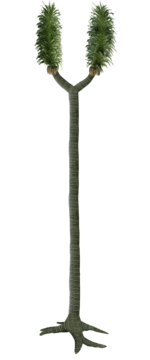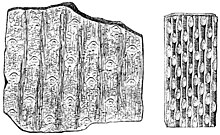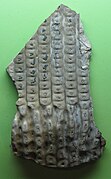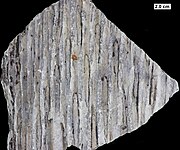|
Sigillaria
Sigillaria is a genus of extinct, spore-bearing, arborescent lycophyte, known from the Carboniferous and Permian periods. It is related to the more famous Lepidodendron, and more distantly to modern quillworts. Fossil recordsThis genus is known in the fossil records from as early as the Middle Devonian or the Late Carboniferous period [1] but dwindled to extinction in the Early Permian period (age range: from 383.7 to 254.0 million years ago).[2] Fossils are found in Great Britain, United States, Canada, China, Korea, Tanzania and Zimbabwe.[3] Description  Sigillaria was a tree-like plant reaching a height up to 30 m (98 ft),[1] and lycopsids were capable to reach a height of up to 50 m (160 ft).[4] These lycopsids had a tall, single or occasionally forked trunk[2] that lacked wood. Support came from a layer of closely packed leaf bases just below the surface of the trunk, while the center was filled with pith. The long, thin grasslike leaves[5] were attached directly to the stem and grew [1] in a spiral along the trunk.[2] The old leaf bases expanded as the trunk grew in width, and left a diamond-shaped pattern, which is evident in fossils. These leaf scars were arranged in vertical rows.[1] The trunk had photosynthetic tissue on the surface, meaning that it was probably green. The trunk was topped with a plume of long, grass-like, microphyllous leaves,[5] so that the plant looked somewhat like a tall, forked bottle brush. The plant bore its spores (not seeds) in cone-like structures [5] attached to the stem.[2][6] The underground structures of arborescent lycophytes including Sigillaria and Lepidodendron are assigned under the form taxon, Stigmaria. The lycopsids had rhizomes or shoot-like rhizomorphic axes, with lateral appendages attached from the circular scars, forming an underground network of branched rootlets. These stigmarian rootlets branched dichotomously from the rhizomorphs similar to Isoetes, and spread throughout the coal swamp forest areas where the lycopods were commonly found. Root hairs from the rootlet scars identified in Stigmaria fossils were attached when the lycopsids were alive.[7] Sigillaria, like many ancient lycopods, had a relatively short life cycle - growing rapidly and reaching maturity in a few years. Sigillaria may have been monocarpic, meaning that it died after reproduction, though this is not proven.[5] It was associated with Lepidodendron and other lycopsids from the Carboniferous coal swamps.[1] SpeciesSpecies within this genus include:[8] 
Gallery
Bibliography
References
External linksWikimedia Commons has media related to Sigillaria. |
||||||||||||||||||||||













